|
|
Latin Squares Tutorial
Latin Squares is a little less straight-forward than some of
my other games, in terms of the deductions (spatial relationships)
that must be spotted. On this page, you'll find a sampling of
the types of deductions and situations that you'll find (and find
useful) within the game.
In the diagrams on this page, I've added letters to the rows
and numbers to the columns as identifiers.
Remember, the rule of the game: There must be one and only
one copy of each letter in each ROW, COLUMN and TILE of the puzzle.
This places major constraints on the placements of the letters.
In this tutorial, I won't talk about deductions involving clues,
as they tend to be fairly simple and straight-forward (and fairly
well explained by the game's Hint explanations). Instead, I'll
focus on the deductions that result from the "spatial constraints."
NOTE: while many of the following explanations follow through
a large part of the deduction process of a single puzzle, some
steps are skipped, and sometimes I'll "drop back" and
take an alternate route in order to illustrate a particular situation.
Consider each deduction below as a separate problem/situation
rather than a connected string or sequence. Also, many of the
following deductions will be explained only in terms of
either rows or columns, but not both, for the sake of brevity.
Spatial deductions that apply to rows always apply, after proper
"rotation", to columns, and vice versa. (Or is that
versa vice?)
Deduction #1
 |
Look at the purple tile (top-left W-shape in puzzle). The only
remaining locations that contain the letter E as a possibility
are S2 and S3. These are both in the same row, and since every
tile must contain an E, one of S2 or S3 must be
an E. It doesn't matter which one of them is the E,
either one will then also be the E that's in row S.
Therefore, there can't be any other E's in row S.
So, the E's that are shown as possibilities in S1, S4,
and S5 can be removed. As another way of looking at this, imagine
that one of the E's located in S1, S4, or S5 was
the E in row S. That would force the removal of
the E possibilities in S2 and S3, leaving the purple tile
with NO remaining E possibilities, which would violate
the rule of the game.
Also, T2 & T3 contain the last A possibilities
in the gray tile (the sidewise-T in the bottom center), so the
A's can be removed from T1 and T5.
This deduction is explained in the hint as "X can't
be here as it has to be in this row in another tile."
(Where X is a letter, E or A in the two
examples above.) This same type of deduction applies in the same
way to columns. |
Deduction #2
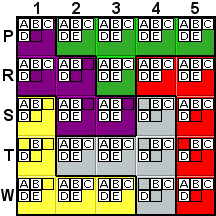 |
T2 and T3 contain the last two A and the last two
E possibilities in the gray tile. Since the A has
to be located in one of those two cells and the E has
to be located in one of those two cells, those two cells can
only be A and E. So, the B, C,
and D possibilities can be removed from T2 and T3. This
is explained in the hint as "These can't be here as it's
one of only 2 locations in this row for 2 other letters."
Another way of looking at it is that B, C, and
D are the only possibilities at 3 locations: S4, T4, and
W4. One of those three must be located at each of those
three locations in order for there to be any letter at
those three locations. That means that those three letters can
not be located anywhere else within the tile, specifically
at T2 and T3.
This same deduction applies to column 4, where A and
E are only possible in P4 and R4, so B,
C, and D can't be in those two locations. |
Deduction #3
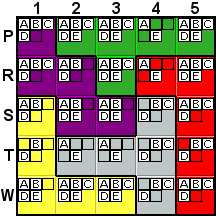 |
This one's a little trickier. R3 can not be A or
E. If it were A, for example, then that would the
A in the green tile (which would force the removal of
the A from all other green cells, including P4), and it
would also be the A in the R row, forcing the removal
of A from all other cells in the row, including R4. This
would remove all A's from column 4, which would
violate the rules of the game. This is an example of a deduction
which is simple enough for most human players to be able to see,
but which the game program would use a What-If to deduce. |
|
Deduction #4

|
Look at the green tile. You will notice that all of the green
cells are in the same row, P, except for one, R3. Further,
that the green cells take up all of the cells in row P except
for one, P1. Whatever letter is located in R3 can not
be in any of the other green cells, which leaves only P1 as the
location in row P for whatever letter is located in R3.
In other words, in this kind of situation, you instantly know
that P1 and R3 must contain the same letter. So, any time
one of them contains a possibility that is not in the other,
that possibility can be removed. In this example, the A
can be removed from P1. Another way of looking at this is that
all green A's are in row P, so no matter where the green
A is located, it will be in row P, so A cannot
be located in any other tile in row P, specifically P1. This
is explained in the hint as "A can't be here as
it has to be in this row in another tile."
A similar relationship exists between R4 and P5. All of the
red cells except for R4 are in column 5, so whatever letter is
located at R4 must also be located at P5. So, B, C,
and D can be removed from P5. |
Deduction #5
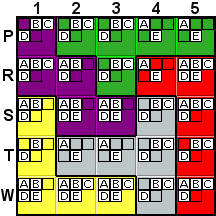 |
W1 must be E, as it's the last cell in column 1 with E
as a possibility. This is explained in the hint as "Last
place in column for E." |
Deduction #6
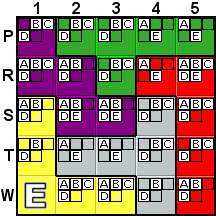 |
Here's another deduction that you can make fairly easily through
simple observaton, but which the program will need to use a What-If
to deduce. The green tile is contained entirely within rows P
and R, so all of its C possibilties are within
those two rows. The purple tile exists within rows P,
R, and S, but it has no C possibilities
remaining in row S. So, both the green and the
purple C's must be in rows P and R. Either
the green C is in row P and the purple C
is in row R, or vice versa. Either way, there's no room
left in rows P and R for a C in any other
tiles. Therefore, we can remove the red C from R5. |
Deduction #7

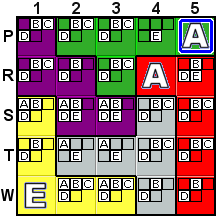
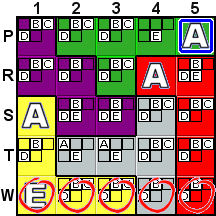 |
Here we'll step through a "What-If" type of deduction.
As mentioned in Deduction #4, R4 and P5 must contain the
same letter. Let's suppose (what-if) that P5 A
(by depressing the What-If button and then left-clicking on the
A). That means that R4 is also A (as shown in the
second picture).
Now, in the second picture, you'll notice that the placement
of the A in R4 has forced the removal of the A
possibility from R1, leaving S1 as the only possible location
for A in column 1.
Placing the A in S1 results in the situation shown
in the third picture, where there are no A possibilities
left in row W. This obviously violates the rule of the game,
so our initial supposition (the A in P5) can not
be right. Therefore, since P5 cannot be A, it must be
E. So, we would undo all of the deductions we'd made (by
unclicking the What-If button), and then removing the A
from P5. |
Deduction #8
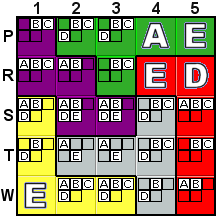 |
S2 and S3 contain the last two possibilities for both D
and E, so those two locations have to be those
two letters and can't be A or B. This deduction
is very similar to Deduction #2, but practice makes perfect... |
Deduction #9
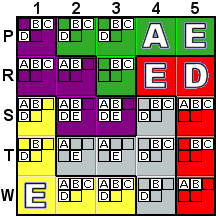 |
Similar to Deduction #4, but a bit more complex to see,
S1 and R2 must contain the same letter. You will notice that
S1 is in the same row or the same column as every other
purple cell except for R2. That means that no matter what
letter is placed in S1, that letter will be removed as a possibility
from every cell of the purple tile except for R2, forcing R2
to contain the same letter as S1. This means that the D
can be removed from S1, since it's not possible in R2. In other
words, placing D at S1 would remove all D
possibilities from the purple tile, so that can't be. This is
another situation that the program would use a What-If to spot,
but that can be easily seen by the human eye. |
Deduction #10
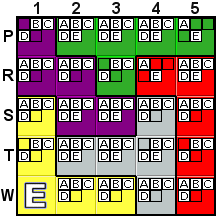 |
In this situation, the A can be removed from S4 and W4,
because the only remaining A's in row T are in the gray
tile, so no A's can be allowed in any other rows
of the gray tile or they would cause the removal of all remaining
A's from row T. |
|
|













